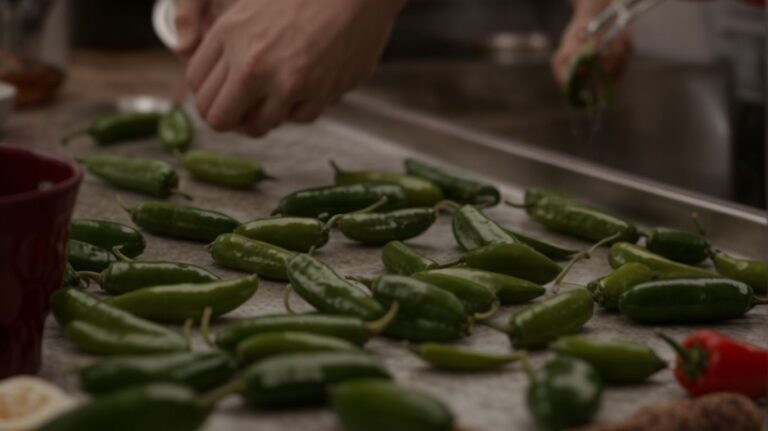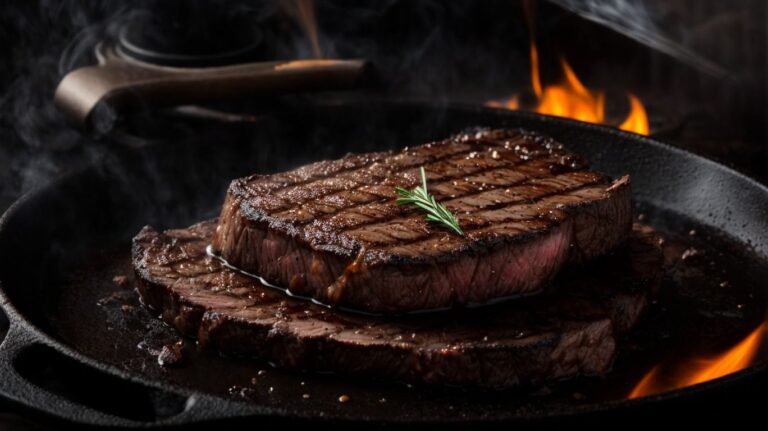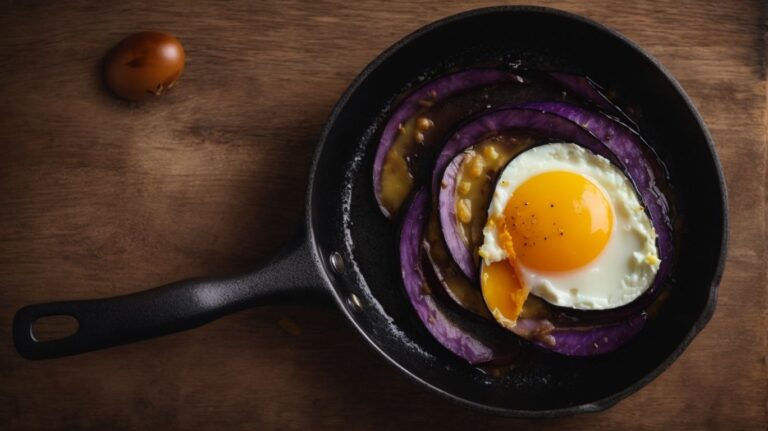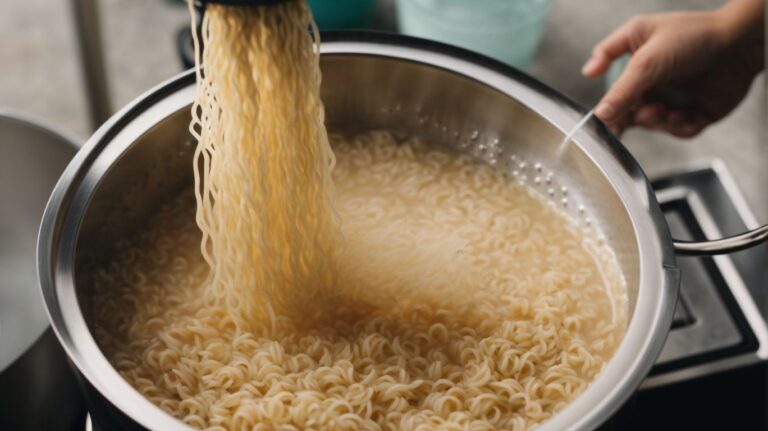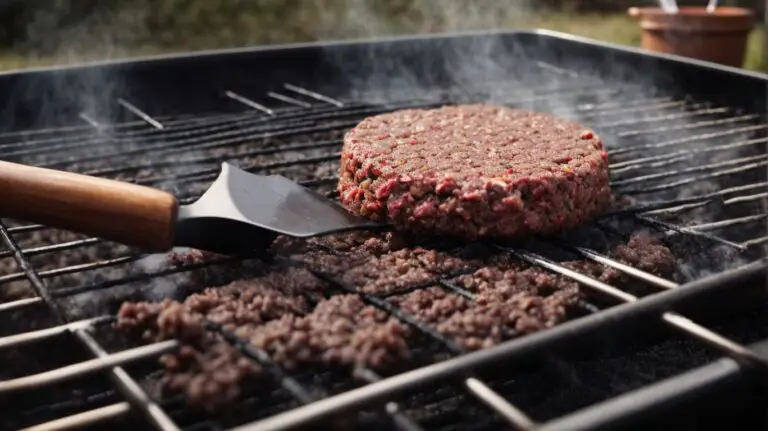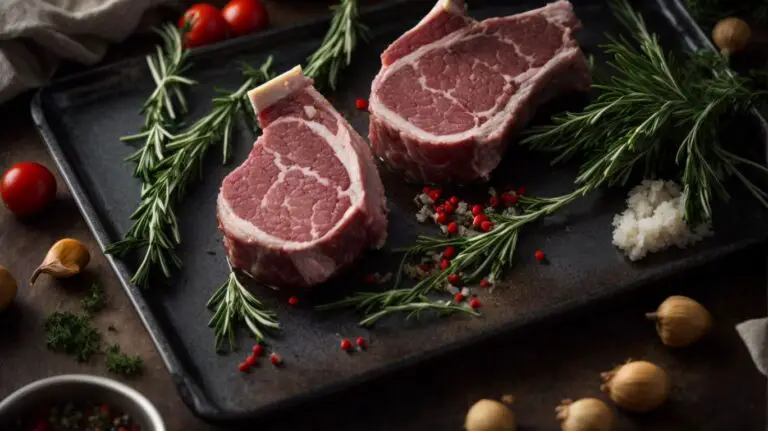How to Cook Jacket Potato Without Microwave?
Are you tired of cooking jacket potatoes in the microwave and missing out on the delicious taste and texture?
Discover why cooking jacket potatoes without a microwave is the way to go. From the health benefits to the better taste and texture, you’ll see why this method is worth a try.
We’ll also provide you with a step-by-step guide on how to cook jacket potatoes without a microwave, along with some tips for perfectly cooked potatoes. So, grab your potatoes, oven or grill, and let’s get cooking!
Key Takeaways:
Why Cook Jacket Potato Without Microwave?
Cooking jacket potatoes without a microwave offers numerous benefits, ranging from enhanced health advantages to superior taste and texture.
Unlike microwaving, traditional oven-baking ensures that the potatoes cook evenly, resulting in a consistently delicious and fluffy interior encased in a crispy skin. The slow cooking process at a lower temperature allows the natural flavors of the Baked Potatoes to develop fully, enhancing the overall taste experience.
Baking Baked Potatoes in the oven retains more of their nutrients compared to microwaving, where some vitamins and minerals might be lost in the process. This method also avoids any potential health concerns related to using plastic containers or wraps in the microwave.
Health Benefits
Regarding health benefits, jacket potatoes serve as a nutritious option that can be enjoyed as both a main dish or side dish.
One of the main advantages of indulging in jacket potatoes is their remarkable nutritional value. These potatoes are a great source of fiber, which can aid in digestion and promote overall gut health. In addition, they are rich in potassium, an essential mineral that supports heart health and helps regulate blood pressure.
Jacket potatoes are low in fat and calories, making them a healthier alternative to fried options. They are also versatile, allowing you to customize them with nutritious toppings like vegetables, lean proteins, and healthy fats.
Better Taste and Texture
Cooking jacket potatoes without a microwave ensures a delightful eating experience with crispy skin and a fluffy interior that is unmatched in taste and texture.
When preparing baked potatoes sans the microwave, the gradual cooking process allows the natural flavors to intensify while ensuring that the skin crisps up beautifully. The slower cooking method promotes a more even distribution of heat, resulting in a fluffier interior that is light and airy. By baking your potatoes, you enhance the richness of the flavors and achieve a satisfying contrast between the crispy exterior and the soft, pillowy insides.
What You’ll Need to Cook Jacket Potato Without Microwave
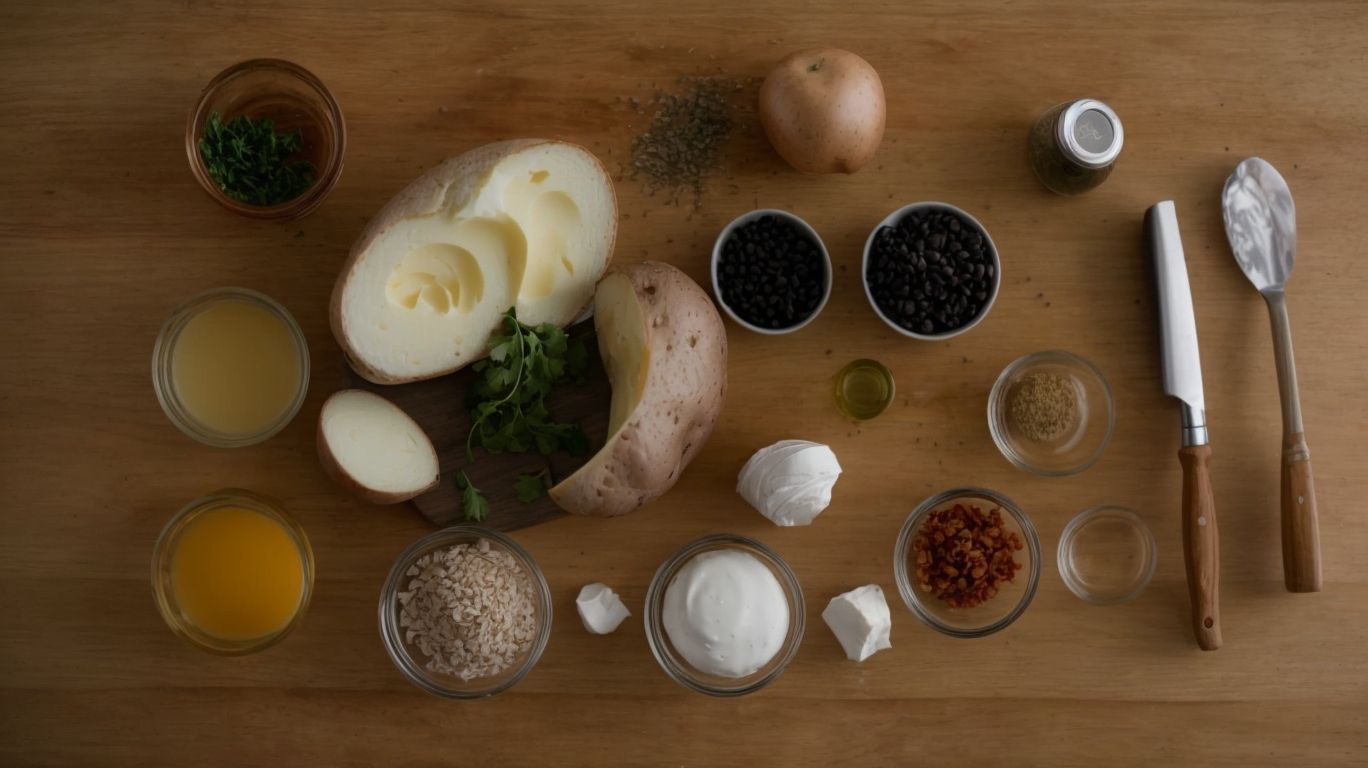
Credits: Poormet.Com – Michael White
To cook jacket potatoes without a microwave, essential items such as an oven, aluminum foil, olive oil, and seasonings like salt and pepper are required.
Preparation of delicious jacket potatoes without using a microwave involves a few key components.
- Begin by selecting medium-sized baking potatoes, preferably russet or Yukon Gold, as they are ideal for baking.
- You will need a sharp knife to pierce the skin of the potatoes, preventing them from exploding in the oven.
- To enhance the flavor and texture, gather aluminum foil to wrap the potatoes, sealing in moisture and heat.
- Coat the potatoes with a generous drizzle of olive oil to promote crispy skin.
- Season with a sprinkle of salt and pepper for a perfect balance of flavors.
Potatoes
Selecting the right type of potatoes, such as Russet potatoes or sweet potatoes, is crucial for achieving the desired flavor and texture in your jacket potato.
When choosing Russet potatoes, known for their starchy and fluffy texture, you ensure a crispy outer skin and a soft, mealy interior, making them ideal for classic jacket potatoes.
On the other hand, sweet potatoes offer a naturally sweet taste and creamy consistency, adding a unique twist to your jacket potato.
The choice of potato variety can greatly influence the overall taste and mouthfeel of your dish. For instance, using baked sweet potatoes instead of Russets will result in a sweeter, more vibrant flavor profile, which pairs wonderfully with savory toppings like cheese, bacon, or herbs. Conversely, opting for mashed potatoes as the base can create a richer, creamier filling for your jacket potato.
Oven or Grill
Utilizing either a toaster oven or a traditional oven ensures even cooking and allows for additional dishes like roasted broccoli to accompany your jacket potato.
Both toaster ovens and traditional ovens are versatile appliances that can produce perfect jacket potatoes with crispy skins and fluffy insides. The consistent heat distribution in these ovens helps in achieving that desirable texture. By using either of these cooking tools, you have the option to prepare complementary side dishes such as roasted broccoli, enhancing the overall meal experience. The oven’s ability to evenly cook the jacket potato ensures a delicious and satisfying result every time.
Aluminum Foil
Wrapping the potatoes in aluminum foil not only aids in even cooking but also helps retain the moisture, resulting in delicious baked potato skins.
By creating a barrier between the potato and the oven’s heat, the foil ensures that the potato cooks evenly from all sides, preventing an overcooked exterior and undercooked interior. This process allows the potato skins to crisp up beautifully while the inside remains fluffy and tender.
The foil wrapping locks in the natural moisture of the potatoes, preventing them from drying out during the baking process. This retained moisture plays a crucial role in enhancing the texture and flavor profile of the baked potato, resulting in a mouthwatering dish that is loved by many.
Olive Oil
Adding a drizzle of olive oil and seasoning to your jacket potato before baking enhances the flavor profile and contributes to a mouthwatering dish.
The text is already formatted with HTML tags.
Salt and Pepper
A generous sprinkle of salt and pepper, along with optional toppings like butter or sour cream, elevates the flavors of your perfectly baked jacket potato.
Seasoning with salt and pepper is essential to bring out the natural flavors of the potato while adding a savory kick to each bite. The contrast of the saltiness and spiciness from the pepper complements the starchy goodness of the potato.
Adding a dollop of butter on top of your steaming hot jacket potato adds a rich, creamy texture that melts into each crevice, enhancing the overall indulgence of the dish.
Alternatively, a spoonful of sour cream provides a tangy twist that balances out the richness of the butter, creating a harmonious blend of flavors that tantalize your taste buds.
Step-by-Step Guide to Cooking Jacket Potato Without Microwave
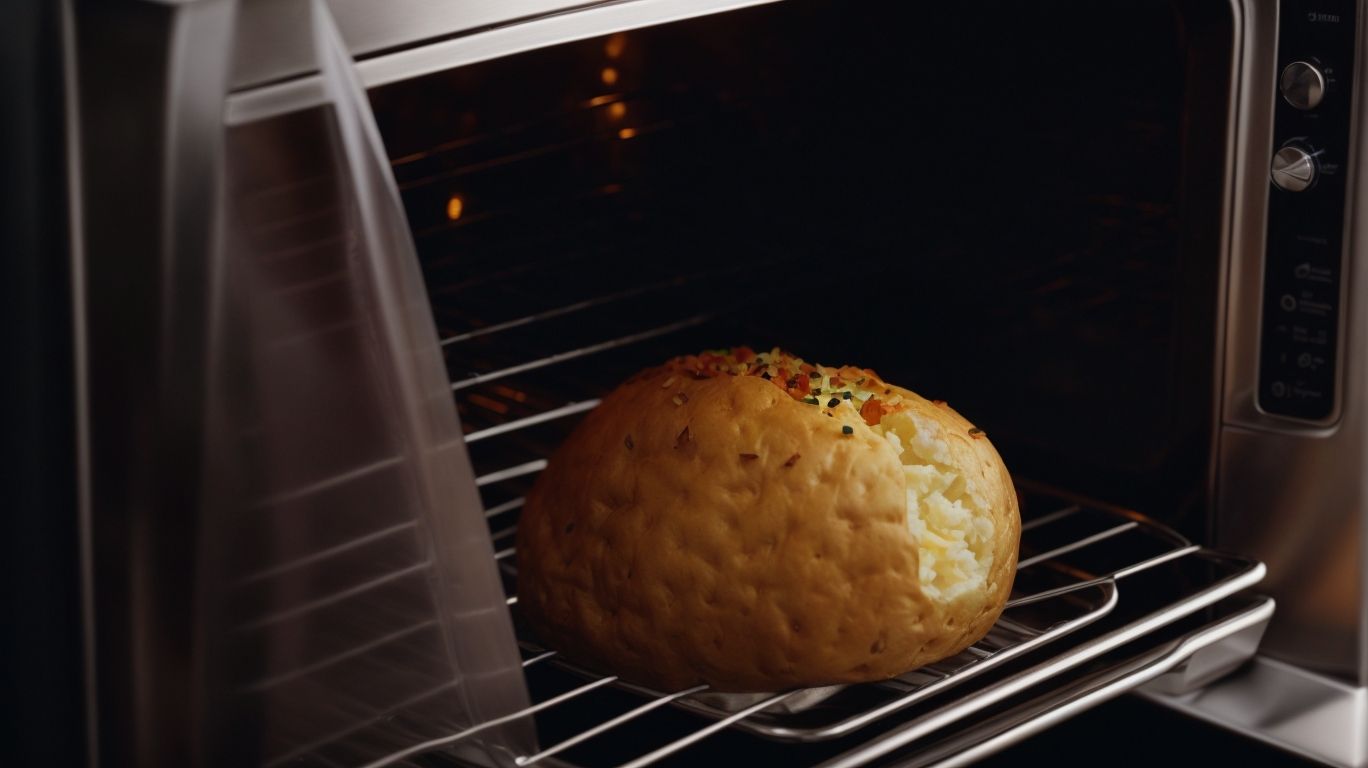
Credits: Poormet.Com – Kenneth Davis
Follow these step-by-step instructions to achieve perfectly baked jacket potatoes without using a microwave, ensuring a crispy skin and fluffy interior.
To begin, thoroughly wash and dry your jacket potatoes. Using a fork or a potato pricker, prick the skin of each potato several times to allow steam to escape during the baking process.
Next, season the potatoes with olive oil, salt, pepper, and any other desired herbs or spices. Preheat your oven to 200°C and place a wire rack on a baking sheet. Arrange the potatoes on the wire rack, ensuring they have enough space around each one to allow even cooking.
Bake the potatoes for around 60-75 minutes, or until they are tender when pierced with a fork. Once done, remove them from the oven and let them cool slightly before serving. Enjoy your delicious homemade jacket potatoes!
Preheat the Oven or Grill
Begin the process by preheating your oven or grill to the recommended temperature for oven-baking or consider alternative methods like slow cookers or air fryers.
Preheating your oven or grill is a crucial step when preparing jacket potatoes. This initial heating process ensures that the oven or grill reaches the optimal temperature for cooking the potatoes thoroughly and evenly. Proper preheating helps in achieving that crispy skin on the outside while keeping the insides fluffy and fully cooked.
If you opt for using a slow cooker or air fryer for making jacket potatoes, ensure you follow the specific cooking guidelines provided for these appliances to achieve the desired texture and flavor of your potatoes.
Prepare the Potatoes
Clean and scrub the potatoes thoroughly, and consider adding toppings like sea salt or other seasonings for a flavorful twist to your baked potato.
To start, make sure to choose potatoes that are uniform in size and shape, which will ensure they cook evenly. Next, carefully wash each potato under cold running water to remove any dirt or debris. Then, using a vegetable brush, scrub the skin to get rid of any remaining grit or dirt. Once the potatoes are clean, pat them dry with a towel.
After cleaning, preheat the oven to the desired temperature, usually around 400-425°F. Prick each potato a few times with a fork to allow steam to escape during baking. Rub the skin with olive oil and a generous sprinkle of sea salt for a simple yet delicious flavor profile.
Wrap the Potatoes in Aluminum Foil
Wrap the seasoned potatoes in aluminum foil, ensuring to prick them with a fork to allow steam to escape during baking for perfectly cooked jacket potatoes.
Properly wrapping the potatoes in aluminum foil helps to lock in moisture and flavor while protecting them from direct heat, resulting in a tender and evenly cooked interior.
Pricking the potatoes is crucial as it prevents them from bursting as steam builds up inside during baking, ensuring they cook through evenly. This simple step also helps to avoid a soggy texture by allowing excess moisture to escape.
Remember to wrap each potato individually in foil and place them on the oven rack or grill for approximately 45-60 minutes, depending on their size, until they are fork-tender.
Add Olive Oil, Salt, and Pepper
Drizzle olive oil over the wrapped potatoes and season generously with salt and pepper before placing them in the oven for baking, ensuring a flavorful outcome.
Applying a liberal amount of olive oil not only helps in keeping the potatoes moist but also infuses a rich, fruity flavor as it seeps into the soft flesh during baking. The seasoning of salt and pepper acts as the perfect complement to the natural earthiness of the potatoes, adding depth and enhancing the overall taste profile. As the potatoes bake, the olive oil and seasoning create a tantalizing aroma that fills your kitchen, creating anticipation for the delicious dish that is soon to be served. This simple yet crucial step ensures that every bite of these baked potatoes is bursting with savory flavors.”
Bake or Grill the Potatoes
Place the prepared jacket potatoes in the preheated oven or grill for the specified time, ensuring a golden-brown exterior and a fluffy interior in your final baked potatoes.
When baking jacket potatoes in the oven, make sure to place them directly on the rack or on a baking sheet lined with foil for easy cleanup. If you are using a traditional oven, consider wrapping the potatoes in foil during the initial cooking time to retain moisture before unwrapping for the last bit of cooking to crisp up the skin.
On the other hand, if you’re using a toaster oven, adjust the temperature and time accordingly, as the smaller size of a toaster oven may require shorter cooking times. Keep a close eye on the potatoes towards the end of the process to achieve that perfect balance between a crispy skin and a soft, fluffy center.
Check for Doneness and Serve
Verify the doneness of the jacket potatoes by checking the potato skins for crispness and ensuring they are tender inside, then serve with optional toppings like olive oil or additional seasonings.
When checking the potato skins, you’re looking for a golden-brown color with a crispy texture, indicating that they’re perfectly cooked. To ensure they’re tender inside, use a fork to gently pierce the potato. If the fork slides in easily and the interior feels soft, your potatoes are ready.
- For serving suggestions, drizzle a generous amount of olive oil over the potatoes, or sprinkle them with your favorite seasonings like salt, pepper, or a mix of herbs.
Experiment with toppings like sour cream, grated cheese, or chives to add extra flavor and texture to your jacket potatoes. Enjoy this versatile and satisfying dish with your choice of accompaniments for a delightful meal.
Tips for Perfectly Cooked Jacket Potatoes
Achieve the perfect jacket potatoes by following these expert tips, from selecting the right potatoes to exploring creative variations like rosemary potatoes or roasted sweet potato rounds.
When choosing potatoes for your jacket potato recipe, opt for starchy varieties like Russet or Maris Piper, as they result in a fluffy interior when baked. Before baking, scrub the skins thoroughly and pat them dry to achieve that crispy texture that complements the creamy filling. For a twist on the classic jacket potatoes, try adding flavorful ingredients like cheddar cheese, bacon bits, or potato skins. These additions can elevate your dish and add a delicious complexity to the flavor profile.
Choose the Right Potatoes
Opt for the ideal potatoes for jacket potato preparation, such as red potatoes or russet potatoes, to ensure a flavorful and satisfying outcome with delectable potato skins.
Red potatoes are known for their waxy texture, which holds up well during baking, resulting in a creamy interior that pairs perfectly with various toppings.
On the other hand, choosing the right russet potato can give your jacket potato a fluffy, light texture, ideal for absorbing flavors and achieving that sought-after crisp skin.
Not only do the type of potatoes affect the texture of the jacket potato, but they also contribute significantly to the flavor profile. Red potatoes offer a subtly sweeter taste compared to russet potatoes, while the latter provides a more earthy flavor.
Don’t Overcrowd the Oven or Grill
Ensure even baking by avoiding overcrowding in the oven or grill, utilizing a cooking rack for proper air circulation and monitoring factors like convection for optimal results.
When using a cooking rack, you create space for hot air to circulate around the food, ensuring that it cooks evenly and efficiently. This prevents uneven baking or roasting, which can lead to some parts being overcooked while others remain undercooked. Additionally, convection ovens are particularly helpful in this regard, as they have a fan that circulates hot air, speeding up the cooking process and reducing the risk of hot spots.
Use a Meat Thermometer to Check for Doneness
Ensure the jacket potatoes are cooked to perfection by employing a meat thermometer to gauge internal temperatures accurately, ensuring ideal doneness based on factors like total fat, fiber, and protein content.
When using a meat thermometer for **jacket potatoes**, it’s crucial to understand the recommended internal temperatures for different levels of doneness. For instance, a potato with a high **total fat** content may require a slightly higher temperature to render it tender without overcooking. The **fiber** and **protein** content can impact the overall cooking time, influencing the desired outcome. By monitoring these elements closely and adjusting cooking times accordingly, you can achieve consistently delicious and nutritious jacket potatoes every time.
Conclusion
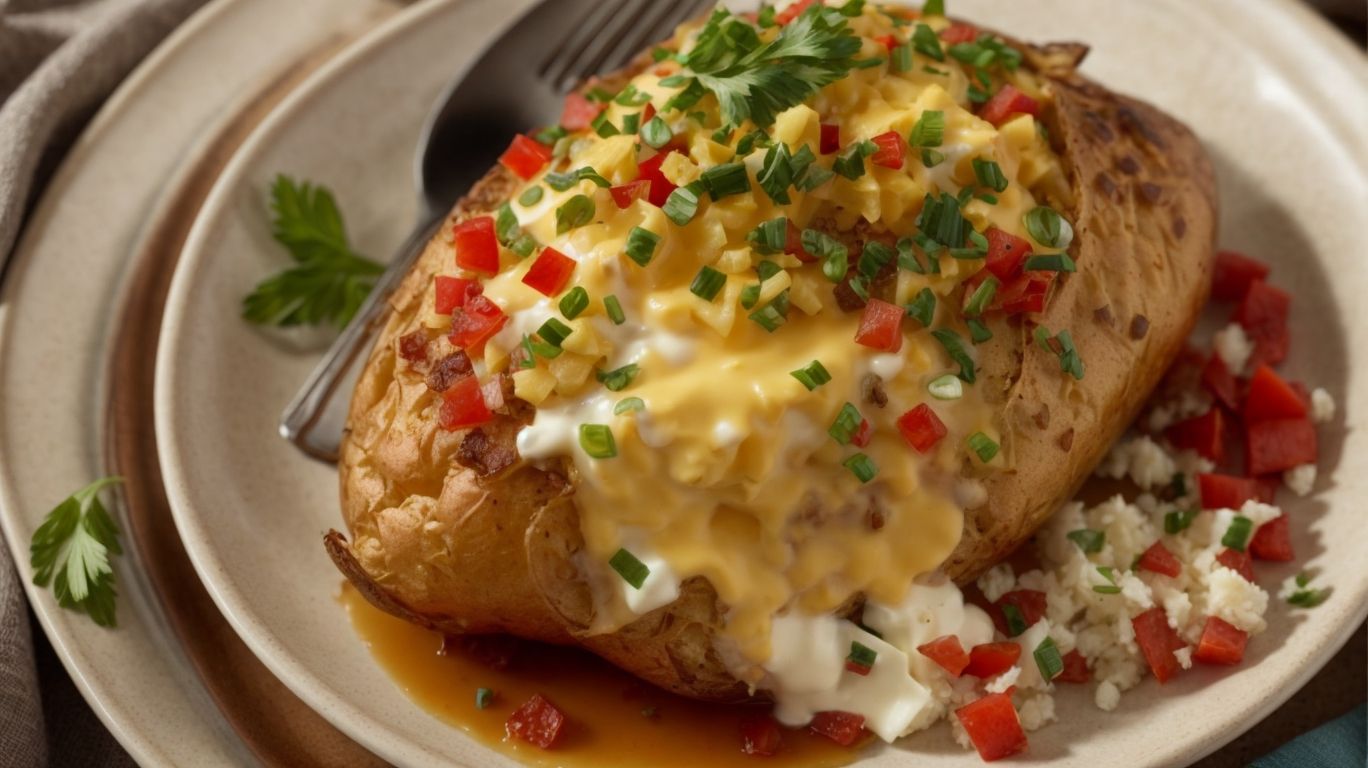
Credits: Poormet.Com – Zachary Smith
Cooking jacket potatoes without a microwave not only enhances the flavor and texture but also allows for creative additions like convection cooking and roasted broccoli as complementary dishes.
By opting for traditional baking methods, the jacket potatoes develop a delightful crispy skin while maintaining a fluffy interior – a perfect balance of textures. When prepared in a convection oven, the even heat distribution ensures uniform cooking and a consistent texture throughout the potato. This cooking method also helps in intensifying the natural flavors of the potato, resulting in a more delicious and savory dish.
Serving the crispy-skinned baked potatoes alongside roasted broccoli not only adds a healthy touch to the meal but also provides a variety of flavors and textures that complement each other perfectly. The smoky notes from the roasted broccoli pair exceptionally well with the earthy richness of the jacket potatoes, creating a harmonious and satisfying dining experience.
Frequently Asked Questions
How to Cook a Perfect Jacket Potato Without a Microwave?
To cook a perfect jacket potato without a microwave, follow these simple steps:
- Preheat your oven to 375°F (190°C).
- Scrub the potato clean and pat it dry with a paper towel.
- Pierce the potato with a fork all around.
- Place the potato on a baking sheet or directly on the oven rack.
- Bake for 45-60 minutes, depending on the size of the potato.
- Remove from the oven and let it cool for a few minutes before serving.
Can I Boil a Jacket Potato Instead of Baking It?
Yes, you can boil a jacket potato instead of baking it. Follow these steps:
- Bring a pot of water to a boil.
- Scrub the potato clean and prick it with a fork.
- Add the potato to the boiling water and cook for 15-20 minutes, until tender.
- Remove from the pot and let it cool before serving.
What Are Some Delicious Toppings for Jacket Potatoes?
Some delicious toppings for jacket potatoes include:
- Butter and grated cheese
- Baked beans and cheese
- Sour cream and chives
- Chili and cheese
- Tuna and sweetcorn
- Bacon and ranch dressing
Can I Cook a Jacket Potato in a Slow Cooker?
Yes, you can cook a jacket potato in a slow cooker. Follow these steps:
- Scrub the potato clean and prick it with a fork.
- Wrap the potato in foil and place it in the slow cooker.
- Cook on low for 6-8 hours or on high for 3-4 hours.
- Remove from the slow cooker and let it cool before serving.
How Do I Make a Crispy Skin on My Jacket Potato?
To make a crispy skin on your jacket potato, follow these steps:
- Before baking, coat the potato in olive oil and sprinkle with sea salt.
- Bake in a preheated oven at 425°F (220°C) for 15 minutes.
- Reduce the heat to 375°F (190°C) and continue baking for 45-60 minutes, until tender.
- Remove from the oven and let it cool before serving.
How Long Will a Cooked Jacket Potato Last in the Fridge?
A cooked jacket potato will last in the fridge for 3-5 days. To store, let it cool completely and then wrap it in foil or place it in an airtight container before refrigerating. To reheat, either microwave for a few minutes or bake in the oven at 375°F (190°C) for 15-20 minutes.


